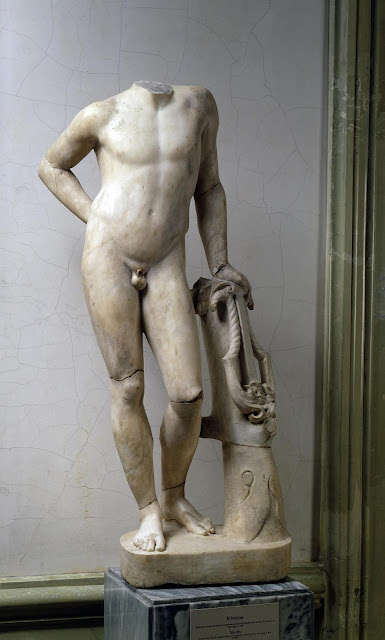 |
| Pan Rome - 2nd century BC marble Hermitage, Saint Petersburg |
 |
| Danaë Rome - 2nd century AD marble Hermitage, Saint Petersburg |
 |
| Torso of an athlete Rome - 1st century AD marble Hermitage, Saint Petersburg |
 |
| Torso of an Emperor Rome - 2nd century AD marble Hermitage, Saint Petersburg |
An antique statue without a head is a great inspirer of confidence. Relatively few antique torsos were discovered with attached heads, yet a quite high proportion of the antique torsos on view in the world since the Renaissance have been displayed with attached heads. How is this possible? Patched-together composites of ancient fragments (with newly carved bits filling in gaps) were created, mostly in Italy, and marketed all over Europe until well along in the 19th century. A frankly headless torso or statue is simply less likely to have been misleadingly interfered with.
 |
| Isis Rome - 2nd century AD marble Hermitage, Saint Petersburg |
 |
| Portrait head of a woman Rome - AD 160-170 marble Hermitage, Saint Petersburg |
 |
| Head of an athlete Rome - 2nd century AD marble Hermitage, Saint Petersburg |
 |
| Portrait of Cornelia Salonina Rome - AD 250 marble Hermitage, Saint Petersburg |
 |
| Portrait of Emperor Lucius Verus Rome - AD-150-175 marble Hermitage, Saint Petersburg |
 |
| Artemis Rome - 2nd century BC marble relief-fragment Hermitage, Saint Petersburg |
 |
| Ganymede with Eagle Rome - 2nd century AD marble Hermitage, Saint Peterburg |
 |
| Funerary statue of a man Rome - AD 150-175 marble Hermitage, Saint Petersburg |
 |
| Funerary statue of a woman Rome - AD 150-175 marble Hermitage, Saint Petersburg |
 |
| Fountain statue of Cupid riding Dolphin Rome - 3rd century BC marble Hermitage, Saint Petersburg |
 |
| Panther head on Sphinx body Rome - 1st century AD marble Hermitage, Saint Petersburg |